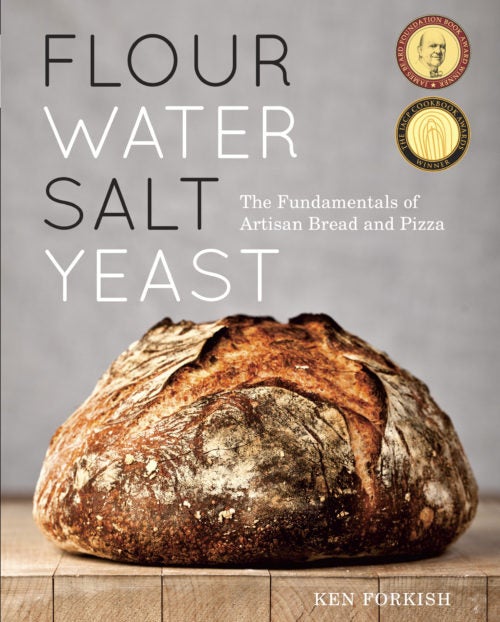









Earlier in the book I pointedly wrote about how the craft of an artisan baker is most evident when the ingredients are just flour, water, salt, and yeast. But man, this is great as an indulgence! I chose an overnight levain dough here because it has more acidity than the other doughs, which complements the fattiness of the bacon. Vitaly Paley, chef and owner of the Portland restaurant Paley’s Place, wishes I would make this bread for him every day. And after he suggested it for French toast, he recanted and said, “The bread is too precious to cook with. I just want to eat it!”
This bread is impressive eaten still warm from the oven or grilled. It soars when toasted and served with eggs and chilled cider or a glass of bubbly. It shines when made into warm, crisp croutons for use in a salad vinaigrette. It sings tenor high notes in a BLT sandwich with lemony mayonnaise and fresh ripe tomatoes. Toasted bacon bread squares with steelhead roe, anyone? Or how about served with a traditional Maryland oyster stew? If I was in Hawaii, I’d have it for breakfast with eggs and fresh papaya or passion fruit. Here in Oregon, it goes great with roasted pears. Maybe the ultimate Elvis sandwich would be this bacon bread with pea- nut butter and bananas. And more bacon.
This dough should have a slightly shorter overnight fermentation time than the other pure levain doughs in this book. The bacon fat makes the yeast extra happy, so the dough will develop more quickly.
Directions
- Feed the levain: About 24 hours after your previous feeding of the levain, discard all but 100 grams of levain, leaving the remainder in your 6-quart tub. Add 400 grams of white flour, 100 grams of whole wheat flour, and 400 grams of water at 85°F to 90°F (29°C to 32°C) and mix by hand just until incorporated. Cover and let rest at room temperature for 9 to 10 hours before mixing the final dough.
- Cook the bacon: At least 20 minutes before autolysing, sauté the 500 grams of bacon until crisp. Drain on paper towels and reserve 2 tablespoons of the rendered bacon fat. Let cool to room temperature, then crumble.
- Autolyse: Between 9 and 10 hours after feed- ing the levain, mix the 864 grams of white flour and the16 grams of whole wheat flour by hand in a 12-quart round tub. Add the 684 grams of 90°F to 95°F (32°C to 35°C) water and mix by hand just until incorporated. Cover and let rest for 20 to 30 minutes.
- Mix the final dough: Sprinkle the 20 grams of salt evenly over the top of the dough. Put a container with about a finger’s depth of warm water on your scale so you can easily remove the levain after it’s weighed. With wet hands, transfer 216 grams (or more if your kitchen is cool; see “Seasonal Variations” on page 134) of levain into the container. Transfer the weighed levain to the 12-quart dough tub, minimizing the amount of water transferred with it. Mix by hand, wetting your working hand before mixing so the dough doesn’t stick to you. Use the pincer method alternating with folding the dough to fully integrate the ingredients. The target dough temperature at the end of the mix is 77°F to 78°F (25°C to 26°C). Let the dough rest for 10 minutes, then spread the 2 tablespoons of bacon fat over the top and sprinkle the crumbled bacon evenly over the top. Incorporate them into the dough, again using the pincer method alternating with folding until the bacon and fat are evenly distributed.
- Fold: This dough needs three or four folds. It’s easiest to apply the folds during the first 1½ to 2 hours after mixing the dough. When the dough is about triple its origi- nal volume, or possibly a little less in winter, about 12 hours after mixing, it’s ready to be divided.
- Divide: With floured hands, gently ease the dough out of the tub and onto a lightly floured work surface. With your hands still floured, pick up the dough and ease it back down onto the work surface in a somewhat even shape. Use a bit of flour to dust the area in the middle where you’ll cut the dough, then cut it into 2 equal-size pieces with a dough knife or plastic dough scraper.
- Shape: Dust 2 proofing baskets with flour. Shape each piece of dough into a medium-tight ball following the instructions on pages 71–73. Place each seam side down in its proofing basket.
- Proof: Set the baskets side by side and cover with a kitchen towel, or place each basket in a nonperforated plastic bag. Proofing time should be 3½ to 4 hours, assuming a room temperature of 70°F (21°C). Use the finger-dent test to see determine when they are perfectly proofed and ready to bake.
- Preheat: At least 45 minutes prior to baking, put a rack in the middle of the oven and put 2 Dutch ovens on the rack with their lids on. Preheat the oven to 475° (245°C)F. If you only have 1 Dutch oven, put the second loaf into the refrigerator about 20 minutes before baking the first loaf and bake the loaves sequentially, giving the Dutch oven a 5-minute reheat after removing the first loaf
- Bake: For the next step, please be careful not to let your hands, fingers, or forearms touch the extremely hot Dutch oven. Invert the proofed loaf onto a lightly floured countertop, keeping in mind that the top of the loaf will be the side that was facing down while it was rising—the seam side. Remove the preheated Dutch oven from your kitchen oven, remove the lid, and carefully place the loaf in the Dutch oven seam side up. Cover and bake for 30 minutes, then uncover and bake for 20 minutes, until at least medium dark brown all around the loaf and the bits of bacon studding the crust are completely crisped—maybe even a little charred. Remove the Dutch oven and carefully tilt it to turn the loaf out. Let cool on a rack or set the loaf on its side so air can circulate around it. Let the loaf rest for at least 20 minutes before slicing, give a nod to Elvis, then enjoy.
Reprinted with permission from Flour Water Salt Yeast: The Fundamentals of Artisan Bread and Pizza by Ken Forkish copyright © 2012. Photographs by Alan Weiner copyright © 2012. Published by Ten Speed Press, an imprint of Penguin Random House.

